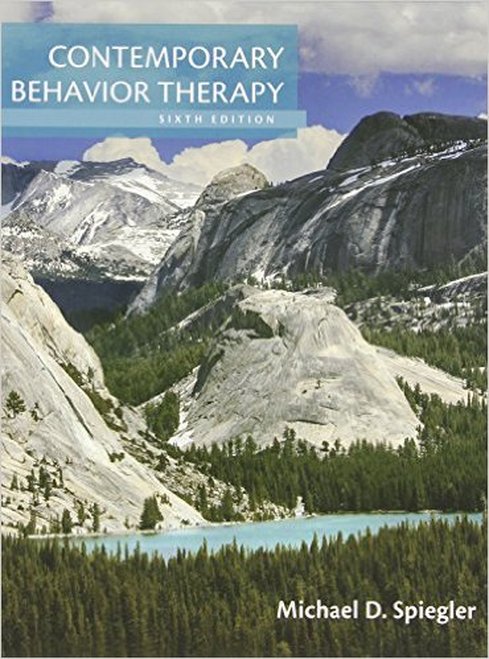Test Bank Contemporary Behavior Therapy Michael D Spiegler 6th Edition Test Bank
$55.00 Original price was: $55.00.$29.99Current price is: $29.99.
Test Bank Contemporary Behavior Therapy Michael D Spiegler 6th Edition Test Bank
Test Bank Contemporary Behavior Therapy Michael D Spiegler 6th Edition Test Bank
Description
Chapter 3
The Behavioral Model
WE ARE WHAT WE DO: PREEMINENCE OF BEHAVIOR
Overt and Covert Behaviors
Covert Behaviors: Special Considerations
Participation Exercise 3-1: Distinguishing Between Overt and Covert
Behaviors
Behavioral Versus Trait Descriptions
Participation Exercise 3-2: Distinguishing Between Traits and Behaviors
Participation Exercise 3-3: Translating Traits into Behaviors
WHY DO WE BEHAVE THE WAY WE DO?
The ABC Model
Maintaining Antecedents
In Theory 3-1: It’s Where You Are (Not Who You Are) That Counts:
Behavior is Situation Specific
Maintaining Consequences
Identifying Maintaining Antecedents and Consequences
In Theory 3-2: The Myth of Symptom Substitution
Participation Exercise 3-4: Identifying Antecedents and Consequences
Present Maintaining Conditions Versus Past Originating Conditions:
A Critical Distinction
Environment and Learning Versus Biology and Heredity
In Theory 3-3: Don’t Look Back: The Role of Past Events on Current Behaviors
In Theory 3-4: Freedom in Reciprocal Determinism
SUMMARY
PARTICIPATION EXERCISE ANSWERS
REFERENCE NOTES
Guiding Questions
3-1. What is behavior, and what is the difference between overt behavior and covert behavior?
3-2. What are the four modes of behavior that are assessed and treated by behavior therapy?
3‑3. How are covert behaviors assessed, and what is the limitation associated with assessing them? How can the limitation be overcome?
3‑4. What are traits, and how are they different from behaviors?
3‑5. What are the problems associated with using trait descriptions?
3-6. What are the advantages to using behavioral descriptions rather than trait descriptions?
3-7. When do behavior therapists deal with traits?
3-8. What is the specific question that behavior therapists ask clients when they use trait descriptions?
3-9. What are antecedents, and what are consequences?
3-10. What is the ABC model, and what are the three components that comprise it? How do each of the components influence one another?
3-11. Why are not all antecedents and consequences of a behavior also maintaining antecedents and maintaining consequences?
3-12. What are the two categories of maintaining antecedents?
3-13. What is meant by the phrase “behavior is under stimulus control”?
3-14. What are the two types of stimulus control?
3-15. What is the difference between a prompt and a setting event?
3-16. What does situation specific mean in terms of behavior?
3-17. Why is the term probable maintaining conditions more accurate than just maintaining conditions?
3-18. What is meant by symptom substitution, and what is the origin of the concept?
3-19. What is the difference between present maintaining conditions and past originating conditions? Why is this distinction important?
3-20. What is the meaning of environment in behavior therapy?
3-21 What is the major role played by heredity and biology in determining behavior, according to the behavioral approach?
3-22. What is the behavioral view of the role of past events on current behaviors, including the status of memories of past conditions?
3-23. What does reciprocal determinism refer to in the context of the behavioral approach?
Multiple Choice Questions
3‑1 (p. 30, b)
According to the behavioral model, people are defined by what they
- experience.
- do.
- learn.
- perceive.
3‑2 (p. 30, a)
Covert behaviors are
- not directly observed by others.
- those occurring outside of therapy.
- a common behavioral complaint.
- not included in the behavioral model.
3-3 (p. 30, d)
One of the four modes of behavior treated in behavior therapy is
- covert.
- imaginal.
- depressive.
- physiological.
3‑4 (p. 30, c)
Information about most covert behaviors must be assumed from
- personality traits.
- environmental conditions.
- overt behaviors.
- standard deviations.
3‑5 (p. 30, c)
One common way to learn about another’s covert behaviors is to
- review behavioral records.
- observe across multiple settings.
- ask the person directly.
- It is impossible to learn about covert behaviors.
3-6 (p. 31, b)
Concentrating is a(n)
- overt behavior.
- covert behavior.
- pseudo behavior.
- trait behavior.
3-7 (p. 32, b)
One probable reason for the widespread use of trait descriptions is that they
- describe the person over time.
- are the briefest alternative.
- provide a lot of specific information.
- paint a more favorable picture.
3‑8 (p. 32, a)
_____ descriptions generally are shorter than _____ descriptions.
- Trait; behavioral
- Behavioral; trait
- Personality; trait
- Covert; overt
3-9 (p. 32, a)
Behavioral descriptions work well in therapy because they
- provide the specific details of a condition.
- reduce variability between clients.
- readily translate to diagnostic categories.
- allow for rapid empirical testing.
3-10 (p. 33, c)
Traits are descriptions of what people
- do.
- believe.
- are.
- experience.
3‑11 (p. 33, a)
Although behavior therapists deal with behaviors rather than traits, they must be able to “translate” traits into behaviors because
- clients often use trait descriptions.
- traits are useful at the beginning of therapy.
- traits can sometimes be more accurate.
- behaviors are inferred from traits.
3-12 (p. 33, b)
The question, “What specific things do you do that lead you to describe yourself as…?” suggests the
- behavioral model’s focus on behavioral causes.
- language barrier between clients and therapists.
- importance of maintaining antecedents.
- need for introspective accounts of one’s behavior.
3-13 (p. 34, b)
According to the behavioral model, behaviors are the direct result of
- uninfluenced decisions.
- present conditions.
- genetic factors.
- developmental experiences.
3-14 (p. 34, d)
Antecedents and consequences designated maintaining differ from other antecedents and consequences in that they are
- greater in number.
- maintained by the behavior.
- constant over time.
- causal for the behavior.
3‑15 (p. 34, c)
The specific antecedents and consequences that cause a person to perform a behavior are called its
- setting events.
- causal factors.
- maintaining conditions.
- stimulus controls.
3‑16 (p. 34, a)
In the behavioral model, the term maintaining is synonymous with
- causal.
- fundamental.
- singular.
- potent.
3-17 (p. 35, b)
Prerequisites are the more basic type of maintaining antecedents because they
- are environmental forces.
- make a behavior possible.
- do not require communication.
- originate within the person.
3-18 (p. 35, c)
Environmental conditions that elicit behaviors are called
- originating conditions.
- prompts.
- setting events.
- situational markers.
3-19 (p. 35, a)
The essential difference between prompts and setting events concerns
- breadth.
- frequency
- intensity.
- efficacy.
3-20 (pp. 34-35, b)
The note which reminded Susan to take out the trash would be all of the following EXCEPT a(n)
- prompt.
- setting event.
- maintaining antecedent.
- antecedent.
3‑21 (p. 36, d)
While in the Dean’s office, Ari spoke quietly and sat in a dignified fashion. Ari then went to a soccer game where he jumped up and down and yelled encouragement to the players. This contrast in Ari’s behaviors can best be explained by the concept of
- multidimensionality.
- past originating conditions.
- reciprocal determinism.
- situation specificity.
3-22 (p. 36, d)
Unlike behavioral descriptions, traits misleadingly suggest that
- individuals are unique.
- people are behaviors.
- the past causes behavior.
- behaviors are consistent.
3‑23 (p. 36, a)
_____ determine whether a behavior will occur in the first place.
- Antecedents
- Probability
- Consequences
- Expectations
3-24 (p. 37, b)
Interestingly, maintaining consequences may affect behavior
- before their temporal occurrence.
- by establishing antecedents.
- even when no antecedent is apparent.
- negatively for some individuals.
3-25 (p. 37, a)
In contrast to antecedents, the effectiveness of a consequence necessarily depends upon
- memory.
- attention.
- change agents.
- the behavior.
3‑26 (p. 37, b)
_____ are directly changed in behavior therapy.
- Behavioral symptoms
- Maintaining conditions
- Target behaviors
- Unconscious conflicts
3-27 (pp. 37, 39, d)
The term probable maintaining conditions is necessary because
- these are the ones involved in symptom substitution.
- a client’s introspection is rarely correct.
- behavioral causes are fundamentally probabilistic.
- these are the ones that are likely to be influencing the behavior.
3-28 (p. 38, d)
The symptom substitution conflict highlights a disagreement between psychoanalytic and behavioral theories concerning the
- concept of free will.
- influence of the therapist.
- reification of mental activity.
- location of behavioral causes.
3‑29 (p. 39, c)
In the behavioral model, past events have _____ influence on present behaviors.
- a direct
- no
- an indirect
- a significant
3-30 (p. 40, c)
The role of past events in causing present behavior is best demonstrated by
- unconscious maintaining conditions.
- multiple consequences maintaining a behavior.
- maintaining antecedents changing over time.
- antecedents becoming consequences.
3-31 (p. 41, a)
Therapists may occasionally inquire about the past origins of a behavior to
- elucidate probable maintaining conditions.
- challenge beliefs about the role of the past.
- satisfy expectations and build rapport.
- encourage the client to face buried causes.
3-32 (pp. 40-42, a)
The behavioral model appreciates biological influences upon behavior but
- shows the influence of the environment upon biology.
- questions its practical importance to clientele.
- highlights its minimal impact within human samples.
- notes that biological descriptions are yet incomplete.
3‑33 (p. 42, d)
Reciprocal determinism serves to elucidate the
- need for therapeutic intervention.
- limitations of environmental causation.
- existence of an unadulterated free will.
- true complexity of the ABC model.
3‑34 (p. 42, d)
When loud music disrupts Michael’s focus, he considers how to alter his environment. This is an example of _____ influencing _____.
- overt behavior; environment
- covert behavior; environment
- overt behavior; covert behavior
- environment; covert behavior
People also search:
contemporary behavior therapy 6th edition
contemporary behavior therapy 6th edition pdf free
contemporary behavior therapy
contemporary behavior therapy pdf
6 contemporary perspectives in psychology












